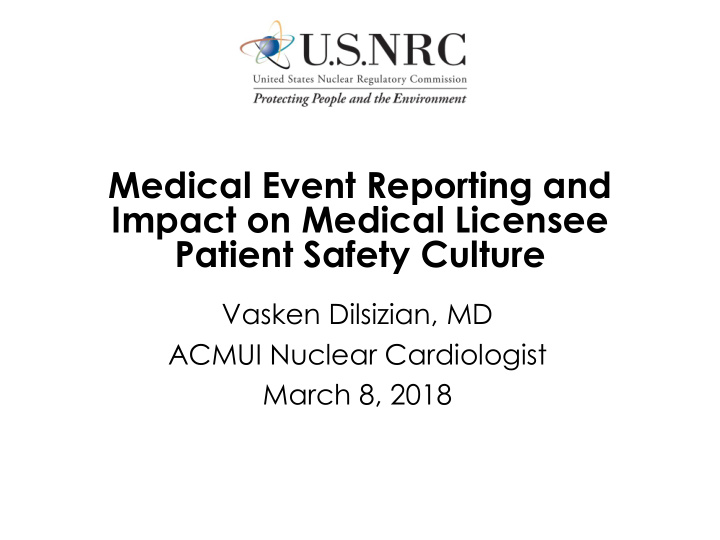



Medical Event Reporting and Impact on Medical Licensee Patient Safety Culture Vasken Dilsizian, MD ACMUI Nuclear Cardiologist March 8, 2018
ME Reporting • ME reporting has not changed significantly for many years. • The annual number of reports is extremely low considering the estimated 15,000,000 diagnostic and 150,000 therapeutic procedures performed annually. 2
ME Rates Are Extremely Low • Does it accurately reflect the true number of cases? • Given the perception of a ME being punitive, are centers reluctant to report MEs? 3
Medical Event vs Medical Error • An ME is not necessarily a violation. However, failure to report a ME is a violation. • Reporting such MEs by a physician may be perceived negatively in most medical centers as they may be interpreted as medical “errors.” 4
What is the Problem That We are Trying to Solve? • Identify potential ways to improve effectiveness of ME self-reporting in support of a culture of safety. • Suggest ways to share ME reports and lessons-learned with the medical community to promote safety. 5
Reporting MEs Educational rather than Punitive • Tracking • Trending • Identifying the problem • Reporting to the medical community • Corrective action • Feedback loop • Constructive improvement • Learn from the Mistakes 6
Guiding Principles • Ideally, NRC should enhance patient safety culture while maintaining its regulatory authority to protect patients during medical use of byproduct materials. • The focus of ME reporting should be on learning and how to avoid/reduce the likelihood of such an event in the future rather than punitive action. 7
Notification of ME and NRC Inspection • For example, MEs rarely cause patient harm, but why is notification required so quickly (no later than the next calendar day after discovery of the ME)? Soon after this notification, an NRC inspection generally takes place looking for violations as cause of the ME. 8
Safety Culture I. “Nuclear” Safety Culture - NRC II . “Patient” Safety Culture in Healthcare - CMS-Approved Accrediting Organizations (AO) – e.g. The Joint Commission. - Patient Safety Organizations (PSO) – e.g. Department of Health and Human Services (HHS). 9
Identity NRC Accrediting or Patient Safety Organizations Reporting information, Reporting is including licensee anonymous to those identity, is posted on outside the hospital, the NRC website and the patient or patient remains even if the advocate, and the event is later AO or PSO. determined by the NRC not to be a medical event. 10 1 0
Information Sharing NRC Accrediting or Patient Safety Organizations Besides posting event report on AO or PSO provides NRC website, NRC posts database to track inspection reports and notices events, and provide of violations and licensee education or tips on responses. If similar events tools, best practices to occur, NRC may issue prevent errors, and regulatory summary document general patient safety alerting licensees or may initiate initiatives to improve rulemaking to prevent future safety culture. events. 1 1
Recommendation for NRC Policy and Regulatory Changes for ME Reporting 1) Define “High” vs “Low” Impact Medical Events. 2)High Impact events will require timely notification to NRC, NRC reactive inspection, and timely written report to NRC. 3)Low Impact events will not require notification to NRC. 1 2
Recommendations Cont. 4) Low Impact events will undergo self- evaluation and corrective action reporting through NRC or NRC-approved Patient Safety Organizations, Accrediting Organizations or institutional robust patient safety program. 5)Ideally, only high impact events should be made public. Low impact events should be anonymous to licensee information and location. 1 3
Reactor Oversight Process (ROP) The NRC staff suggested that the ACMUI explore the ROP program and the way in which the NRC and reactor community developed and tested this change in regulatory oversight for possible methods of implementing NRC ME oversight improvements using current Part 35 reporting regulations. 1 4
Short-Term Recommendation NRC to develop and test a program (like done with ROP) to allow medical use licensee to evaluate MEs (10 CFR 35.3045, 35.1000 guidance, 35.3047) perhaps with an approved patient safety organization (PSO) or CMS- approved AO 1 5
NRC Patient Safety Program • Licensee to report MEs per current requirements. • NRC will not post event report on its website, or will make posting anonymous. • NRC will not conduct reactive inspection except in special “High Impact” medical events. 1 6
NRC Patient Safety Program Cont. • Licensee will develop written report of “Low Impact” ME review for next NRC inspection. • NRC to develop temporary inspection procedures for report reviews and to evaluate enforcement manual changes for MEs to support test program. • Number of participants and length of time to be determined • Evaluate MEs and reports with the ACMUI 1 7
NRC Patient Safety Program Cont. After the test period is completed, NRC should consider opening the program to: • All NRC medical use licensees who request approval of their patient safety program, and • Agreement States who request to implement the program with their medical licensees. 1 8
Acronyms • ACMUI – Advisory Committee on Medical Uses of Isotopes • AO – CMS-approved Accrediting Organization • CFR – Code of Federal Regulations • CMS – Centers for Medicare & Medicaid Services • HHS – Department of Health and Human Services 1 9
Acronyms • ME – medical event (includes 10 CFR 35.3045, 35.1000 guidance, and 35.4047) • NRC – Nuclear Regulatory Commission • PSO – Patient Safety Organization • ROP – Reactor Oversight Process 2 0
Recommend
More recommend